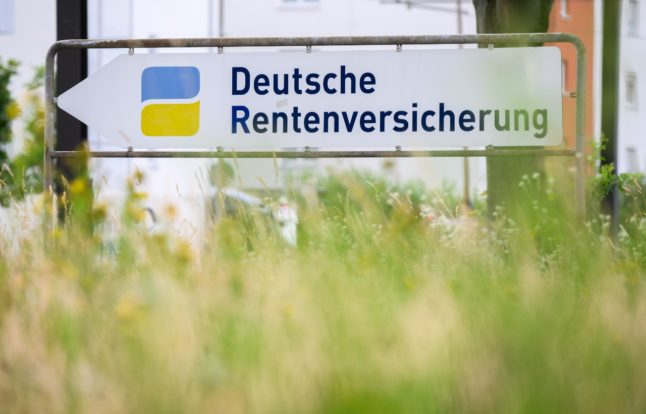Six things to know about Germany's new pension reforms

In the coming weeks, the traffic-light coalition will push through a sweeping revamp of the German pensions system - with a far bigger focus on investments. Here's what it means for foreigners living and working in Germany now.
For foreigners in a new country, getting to grips with pensions can be confusing. A retirement fund is something we all need in our later years, and every country seems to have a different (but equally mind-boggling) system.
Unfortunately, the system in Germany is about to get more complicated than ever. With a new set of reforms, the traffic-light coalition of the SPD, Greens and FDP wants to shore up the pensions of the next generation. That will involve delving into the stock market - something that strikes fear into the hearts of many Germans.
So, what is the new system and what does it mean for foreigners? Are pensions safer - or less safe - than they were before? Here are six key things to know about the reform.
1. It's all about securing future pensions
In Germany, contributions are generally taken out of employee salaries automatically and then matched by your employer. This is averaged out over time in a points-based system and finally calculated based on factors like your income, the age at which you retire and the number of years you paid into the pot.
But don't make the mistake of thinking this is like a fancy government savings account: what you pay in actually goes to fund the current set of retirees, meaning everything depends on a delicate balance between the number of workers in Germany and the number of pensioners. That's where the country is running into trouble right now.

A sign for the German Pensions Fund HQ in Laatzen, Lower Saxony. Photo: picture alliance/dpa | Julian Stratenschulte
With a wave of people from the Baby Boomer generation entering retirement, the balance is set to tip drastically towards the pensioner end, with not enough working-age people to finance them. While foreign workers will certainly play a role in rebalancing this, the government also wants to ensure it can maintain the current pension level of 48.1 percent - or at least not fall below 48 percent.
What that means is that someone who receives an average salary for 45 years of their working life will get 48 percent of that salary paid to them each month upon retirement.
READ ALSO: Germany plans reforms to avoid double taxation on pensions: What you need to know
2. Pension contributions won't rise yet - and neither will the pension age
When the traffic-light coalition entered government, a key pledge of theirs was not to raise the pension age any more than planned. Currently, people can retire at the age of 65 without losing any of their pension entitlement, though this is set to be raised to 67 in stages by 2029.
Though some pressure groups have advocated hiking the pension age further to make up for the imbalance between retirees and working-age people, this has so far been ruled out by ministers.

A pensioner counts euro notes at a table. Photo: picture alliance/dpa | Lino Mirgeler
"Raising the retirement age even further to 69, 70 or 75 is wrong and unfair because that would mean a real pension cut for many people who simply cannot work that long," Labour Minister Hubertus Heil (SPD) said recently.
Additionally, the government says it wants to maintain the level of pensions currently offered without people having to pay more - or too much more - into the system.
Currently, 18.6 of a worker's salary is put into the pension pot, though this is split 50/50 between the employer and the employee. Until 2025 at least, this is capped at no more than 20 percent - meaning 10 percent paid by the employee and 10 percent by the employer.
READ ALSO: Pensions in the EU: What you need to know if you're moving country
3. The government wants to grow the pension pot by investing
There are currently around 21 million pensioners in Germany, making up a quarter of the population - and according to the Federal Office of Statistics, the largest cohort of workers is currently aged 55-60. By 2035, most of these working adults will be 70 or over.
By 2060 - assuming this trend continues - working-age people will only outnumber pensioners by three to two. Right now, there are three working-age people for every one retiree. To solve these tricky mathematics, the government is looking to the stock market.
Under plans set to be presented by Labour Minister Heil and Finance Minister Christian Lindner (FDP), a special €10 billion fund will be made available that will be invested over a number of years.
The idea is to build up "generational capital" that can act as a buffer against demographic change. Over time, as the investments grow, the government can pour money back into pensions to make up for any future shortfall.
This will be added to the two other sources of financing for German pensions that are currently in place: pension contributions and government tax funds.
4. Pensioners won't become stockholders
Originally, the pro-business FDP had campaigned heavily for a Swedish-style system in which two percent of pension contributions would be invested into an equity pension while the remaining 16.6 percent would remain the same.
But after pushback from the centre-left SPD and Greens, this has changed a fair bit.
Instead, the government will borrow €10 billion to invest in the capital market. This will be done as safely as possible, with funds diversified globally and invested over several years. The investment will be managed by a politically independent foundation and if share prices fall, the government will compensate for this out of its own reserves - or more borrowing.

Two elderly pensioners at the seaside in Timmendorf, Mecklenburg Western-Pomerania. Photo: picture alliance/dpa/dpa-Zentralbild | Jens Büttner
This means that pensions are protected from market volatility, but also that if the investment goes up significantly, pensions will remain the same. Ultimately, the goal is simply to stabilise pensions in around 15 years.
Of course, investing in the stock market or in a private pension that's linked to the capital market is still an option for individuals - it just won't happen automatically through the government's new scheme.
READ ALSO: How long do you have to work to receive a German pension?
5. Maintaining the current pension level is really expensive
As a general rule, every one percent increase in the pension level needs to be covered by at least half a percent more pension contributions - equating to around €8 billion.
It remains to be seen how much the €10 billion initial investment fund - or any future investments - will grow, but there are major doubts that it will be enough to rule out any future hikes in contributions.
The government also pours around €100 billion each year from the federal budget into pensions - a number that's only set to rise in the future when the Baby Boomers march into retirement en masse.
In anticipation of forthcoming hikes, the Employers' Association is calling for a cap on social contributions in the future.
READ ALSO: When are people in Germany retiring?
6. There'll be changes to private pensions as well
Since the state pension was conceived as a safety net, people in Germany are encouraged to supplement it with their own private or company pensions.
To improve this side of things, a government committee has recently presented some proposals on how to broaden the offer of private and state-subsidised pensions.
A current system known as the Riester Rente (Riester Pension) is set to be phased out, while new options will be brought in, including riskier but higher-yield investment options. In future, people will also have the option of a private pension that invests in exchange-traded index funds (ETFs).
This will be fleshed out in the future but the noise from the coalition has so far been positive, so it looks like these reforms are almost certain to be brought in.
Comments
See Also
For foreigners in a new country, getting to grips with pensions can be confusing. A retirement fund is something we all need in our later years, and every country seems to have a different (but equally mind-boggling) system.
Unfortunately, the system in Germany is about to get more complicated than ever. With a new set of reforms, the traffic-light coalition of the SPD, Greens and FDP wants to shore up the pensions of the next generation. That will involve delving into the stock market - something that strikes fear into the hearts of many Germans.
So, what is the new system and what does it mean for foreigners? Are pensions safer - or less safe - than they were before? Here are six key things to know about the reform.
1. It's all about securing future pensions
In Germany, contributions are generally taken out of employee salaries automatically and then matched by your employer. This is averaged out over time in a points-based system and finally calculated based on factors like your income, the age at which you retire and the number of years you paid into the pot.
But don't make the mistake of thinking this is like a fancy government savings account: what you pay in actually goes to fund the current set of retirees, meaning everything depends on a delicate balance between the number of workers in Germany and the number of pensioners. That's where the country is running into trouble right now.

With a wave of people from the Baby Boomer generation entering retirement, the balance is set to tip drastically towards the pensioner end, with not enough working-age people to finance them. While foreign workers will certainly play a role in rebalancing this, the government also wants to ensure it can maintain the current pension level of 48.1 percent - or at least not fall below 48 percent.
What that means is that someone who receives an average salary for 45 years of their working life will get 48 percent of that salary paid to them each month upon retirement.
READ ALSO: Germany plans reforms to avoid double taxation on pensions: What you need to know
2. Pension contributions won't rise yet - and neither will the pension age
When the traffic-light coalition entered government, a key pledge of theirs was not to raise the pension age any more than planned. Currently, people can retire at the age of 65 without losing any of their pension entitlement, though this is set to be raised to 67 in stages by 2029.
Though some pressure groups have advocated hiking the pension age further to make up for the imbalance between retirees and working-age people, this has so far been ruled out by ministers.

"Raising the retirement age even further to 69, 70 or 75 is wrong and unfair because that would mean a real pension cut for many people who simply cannot work that long," Labour Minister Hubertus Heil (SPD) said recently.
Additionally, the government says it wants to maintain the level of pensions currently offered without people having to pay more - or too much more - into the system.
Currently, 18.6 of a worker's salary is put into the pension pot, though this is split 50/50 between the employer and the employee. Until 2025 at least, this is capped at no more than 20 percent - meaning 10 percent paid by the employee and 10 percent by the employer.
READ ALSO: Pensions in the EU: What you need to know if you're moving country
3. The government wants to grow the pension pot by investing
There are currently around 21 million pensioners in Germany, making up a quarter of the population - and according to the Federal Office of Statistics, the largest cohort of workers is currently aged 55-60. By 2035, most of these working adults will be 70 or over.
By 2060 - assuming this trend continues - working-age people will only outnumber pensioners by three to two. Right now, there are three working-age people for every one retiree. To solve these tricky mathematics, the government is looking to the stock market.
Under plans set to be presented by Labour Minister Heil and Finance Minister Christian Lindner (FDP), a special €10 billion fund will be made available that will be invested over a number of years.
The idea is to build up "generational capital" that can act as a buffer against demographic change. Over time, as the investments grow, the government can pour money back into pensions to make up for any future shortfall.
This will be added to the two other sources of financing for German pensions that are currently in place: pension contributions and government tax funds.
4. Pensioners won't become stockholders
Originally, the pro-business FDP had campaigned heavily for a Swedish-style system in which two percent of pension contributions would be invested into an equity pension while the remaining 16.6 percent would remain the same.
But after pushback from the centre-left SPD and Greens, this has changed a fair bit.
Instead, the government will borrow €10 billion to invest in the capital market. This will be done as safely as possible, with funds diversified globally and invested over several years. The investment will be managed by a politically independent foundation and if share prices fall, the government will compensate for this out of its own reserves - or more borrowing.

This means that pensions are protected from market volatility, but also that if the investment goes up significantly, pensions will remain the same. Ultimately, the goal is simply to stabilise pensions in around 15 years.
Of course, investing in the stock market or in a private pension that's linked to the capital market is still an option for individuals - it just won't happen automatically through the government's new scheme.
READ ALSO: How long do you have to work to receive a German pension?
5. Maintaining the current pension level is really expensive
As a general rule, every one percent increase in the pension level needs to be covered by at least half a percent more pension contributions - equating to around €8 billion.
It remains to be seen how much the €10 billion initial investment fund - or any future investments - will grow, but there are major doubts that it will be enough to rule out any future hikes in contributions.
The government also pours around €100 billion each year from the federal budget into pensions - a number that's only set to rise in the future when the Baby Boomers march into retirement en masse.
In anticipation of forthcoming hikes, the Employers' Association is calling for a cap on social contributions in the future.
READ ALSO: When are people in Germany retiring?
6. There'll be changes to private pensions as well
Since the state pension was conceived as a safety net, people in Germany are encouraged to supplement it with their own private or company pensions.
To improve this side of things, a government committee has recently presented some proposals on how to broaden the offer of private and state-subsidised pensions.
A current system known as the Riester Rente (Riester Pension) is set to be phased out, while new options will be brought in, including riskier but higher-yield investment options. In future, people will also have the option of a private pension that invests in exchange-traded index funds (ETFs).
This will be fleshed out in the future but the noise from the coalition has so far been positive, so it looks like these reforms are almost certain to be brought in.
Join the conversation in our comments section below. Share your own views and experience and if you have a question or suggestion for our journalists then email us at [email protected].
Please keep comments civil, constructive and on topic – and make sure to read our terms of use before getting involved.
Please log in here to leave a comment.